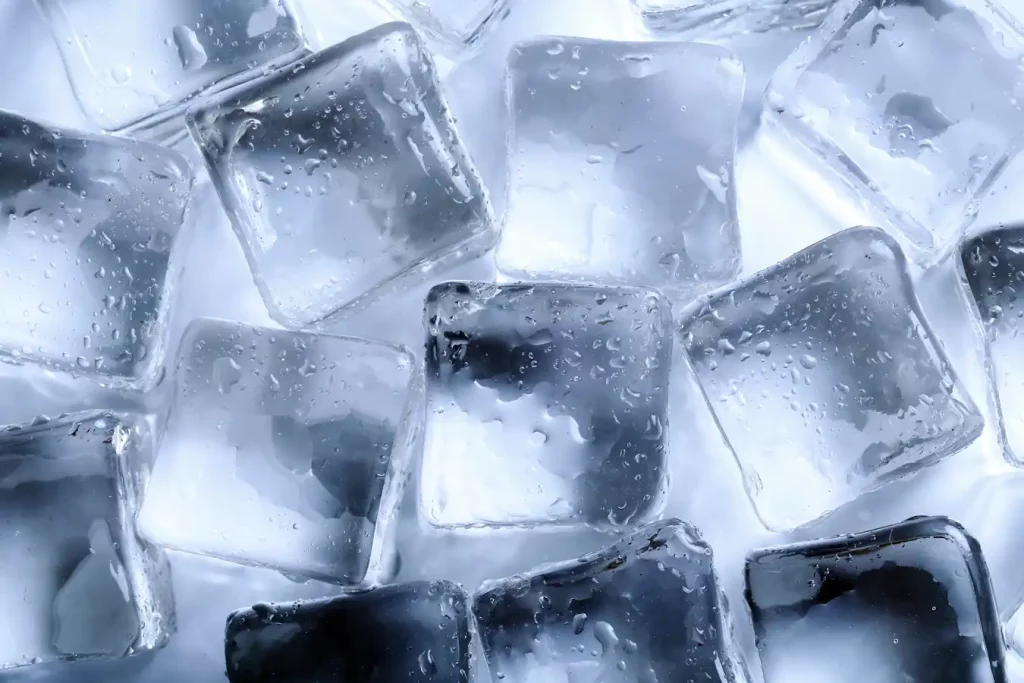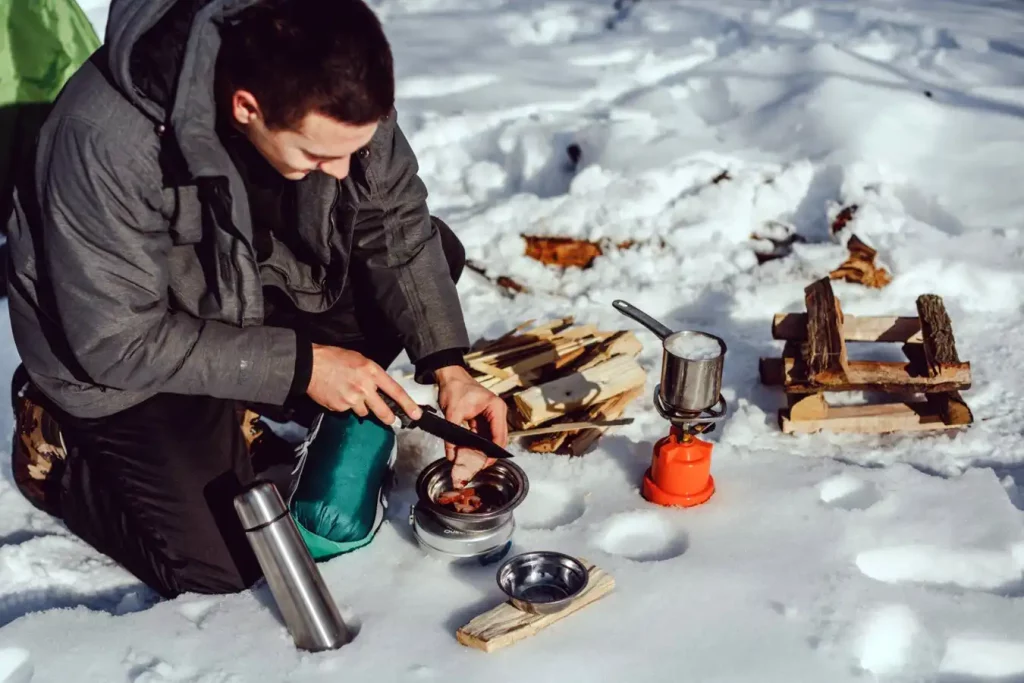Have you ever wondered how to use dry ice for camping?
As your friendly guide, I’m excited to share this cool trick for your camping adventures.
This article aims to educate you on the effective use of dry ice to keep your food and drinks chilled outdoors.
Get ready for a chilling ride as we unveil the secrets of using this sub-zero marvel! Imagine your camping experience elevated with cold beverages and fresh food, anytime you want.
So let’s dive into this icy adventure together!
Understanding Dry Ice
Before we dive into the ‘how-tos’, let’s take a moment to understand the ‘what’ and the ‘why’. Dry ice is not your typical ice. It’s a solid form of carbon dioxide, and instead of melting, it sublimates – meaning it transitions directly from a solid state to a gas. This fascinating property is key to why dry ice is such a useful resource for camping trips.
What is Dry Ice?
Dry ice, as mentioned, is the solid form of carbon dioxide. It’s extremely cold, with a surface temperature of -78.5 degrees Celsius (-109.3 degrees Fahrenheit). Due to this, it’s perfect for cooling items for an extended period. And because it turns directly into gas, there’s no watery mess to deal with, making it ideal for storing food and beverages during your camping adventure.

Safety Precautions when Handling Dry Ice
While dry ice is highly beneficial, it’s crucial to handle it safely. Its extreme cold can cause frostbite if it comes into direct contact with skin. Always use protective gloves or tongs when handling it. Keep it out of reach of children and pets, and never store it in an airtight container as the gas needs to escape to prevent a potentially dangerous build-up of pressure.
Remember, safety is always paramount, especially when we’re out embracing the wild.
Learn more: How to Keep Meat Cold While Camping
Why Use Dry Ice for Camping?
When you’re exploring the great outdoors, the last thing you want is to find your perishable goods spoiled or your cold beverages warmed up. This is where dry ice shines. It’s colder than regular ice, lasts longer, and instead of melting, it sublimates into a gas, meaning no watery mess in your cooler.
Sure, traditional ice cubes or ice packs can help maintain cooler temperatures, but they melt relatively quickly and fill your cooler with water, potentially soaking your food. Dry ice, however, keeps your cooler colder for longer, ensuring that your perishables stay fresh and your beverages chilled throughout your camping trip. The difference is clear – dry ice is the superior cooling option for outdoor escapades.
To know more: How Big of a Cooler Do I Need for Camping
How to Use Dry Ice for Camping: Step-By-Step Guide
To tap into the potential of dry ice for your camping trip, there’s a process you’ll need to follow. This involves obtaining the dry ice, packing it correctly, and disposing of it safely. Let’s break it down.
Buying and Storing Dry Ice
First things first: acquiring your dry ice. Check local grocery stores or gas stations, many of them often stock dry ice. Buy it closer to when you plan to leave for your trip because it sublimates even when stored in a cooler.
For storage, always remember to use an insulated container like a cooler and not an airtight container. This allows the gas to escape and prevents any dangerous build-up of pressure. And don’t forget – use gloves or tongs when handling dry ice to protect your skin from frostbite.
Packing Dry Ice for Your Camping Trip
Now, let’s pack. Begin by placing a layer of regular ice or insulated material at the bottom of the cooler. Then add your dry ice, wrapped in a few layers of newspaper to reduce direct contact with your food items. Place your food and drinks on top, and fill any remaining spaces with crumpled newspaper for additional insulation.
Remember, the goal is to keep the cold air in, so pack your cooler efficiently. And always keep the cooler closed as much as possible during your trip to prolong the life of the dry ice.
Disposing of Leftover Dry Ice
Finally, what to do with any leftover dry ice? You might find at the end of your camping trip that there’s still some dry ice remaining. Do not attempt to dispose of it in a sink or toilet, as it could harm your plumbing due to its extreme cold. The safest way to dispose of dry ice is to let it sublimate completely in a well-ventilated area away from people and pets.
Overall, to use dry ice for camping, wrap it in newspaper, place it atop items in your cooler, and keep the cooler closed as much as possible.
Learn more: How to Freeze Dry Food
Practical Tips for Using Dry Ice
To make the most of using dry ice during your camping trips, here are a few extra pointers:
- Quantity Matters: As a rule of thumb, plan for about 10 to 20 pounds of dry ice for a 24-hour period for a typical cooler. This amount may vary based on the size of your cooler, the outside temperature, and how often you open the cooler.
- Maximize Cooling: To extend the life of your dry ice, insulate it. Wrap the dry ice in newspaper or cardboard. This not only adds a safety layer between you and the ice but also slows down the sublimation process, maximizing the cooling effect.
- Strategic Packing: Pack items that need to stay frozen closest to the dry ice. Keep items you’ll use regularly further away to avoid constant exposure to extremely low temperatures. This also minimizes the number of times you’ll have to reach past the dry ice.
- Respect the Cold: Dry ice can freeze food to the point where it may be difficult to eat until it thaws. Plan meals in a way that takes thawing time into consideration.
Read more: Winter Camping Basics
FAQs about Using Dry Ice for Camping
How Long Does Dry Ice Last in a Cooler for Camping?
Do You Put Dry Ice on Top or Bottom of Cooler?
How Do You Keep Dry Ice from Melting?
How Long Will Dry Ice Last?
Conclusion
From keeping your food fresh to your drinks chilled, dry ice can indeed be a camper’s best friend. It offers several advantages over traditional ice: it’s colder, it lasts longer, and it won’t leave your cooler full of water.
Remember to handle it with care. Buy it close to your departure time, store it in a well-insulated container, and use gloves or tongs when handling it. Pack your cooler strategically to maximize the cooling effect and prolong the life of the dry ice.
Lastly, dispose of any remaining dry ice safely. Let it sublimate in a well-ventilated area, away from people and pets.
With this guide, you’re now well-equipped to use dry ice for your camping needs. So here’s to a cooler, fresher, and more enjoyable outdoor adventure on your next camping trip! Safe travels and happy camping!
To know more: How to Use a Dutch Oven While Camping


